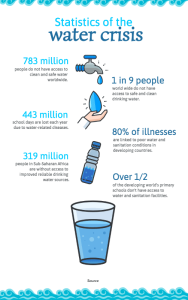According to a recent study by the World Resources Institute (WRI), twenty-five countries with a quarter of the world’s population are facing acute water shortages. WRI statistics indicate that these countries routinely use up to 80 percent of their water reserves each year. Demand for water continues to rise with growing population and development around the world, and demand has doubled since 1960. Demand for water has stagnated in developed countries such as Europe and America, but is increasing in Africa. By 2050, worldwide water demand is projected to increase between 20 and 25 percent. The five countries facing the most water scarcity are Bahrain, Cyprus, Kuwait, Lebanon and Oman.
• Twenty-five countries with a quarter of the world’s population are facing acute water scarcity
• Countries contributing 31 percent or $70 trillion to global GDP will face severe water scarcity by 2050• Water scarcity can be prevented through planning. Singapore and Las Vegas have grown amid water scarcity
• Acute water scarcity threatens lives, employment, food and energy security. Demand for water is increasing faster than available resources
• Lack of water management could cost India, China and Central Asia 7 to 12 percent of GDP by 2050
• An additional one billion people are likely to live with extreme water stress by 2050
• India has lost 8.2 terawatt-hours of energy due to lack of planning
 Photo credit: Venngage Inc
Photo credit: Venngage Inc
According to research, globally, nearly four billion people, or half the world’s population, face acute water scarcity at least one month a year. There is no doubt that by 2050 this figure will touch around 60 percent. Such acute water shortages threaten people’s lives, employment, food and energy security. All over the world, the demand for water is increasing faster than the available resources. The increase in water demand is largely the result of rampant population growth, irrigated agriculture, animal husbandry, energy production and industrial development. On the other hand, there is not enough investment in water infrastructure. Lack of efficient water use policies and global warming are having a major impact on the available water supply.
According to the report, countries contributing 31 percent of global GDP, or $70 trillion, will face severe water shortages by 2050. Worryingly, four countries – India, Mexico, Egypt and Turkey – will account for more than half of this GDP in 2050.
Among the 25 countries facing the most water scarcity today are Bahrain, Cyprus, Kuwait, Lebanon, Oman, Qatar, UAE, Saudi Arabia, Israel, Egypt, Libya, Yemen, Botswana, Iran, Jordan, Chile, San Marino, including India. , including Belgium, Greece, Tunisia, Namibia, South Africa, Iraq and Syria. An additional one billion people are likely to live with extreme water stress by 2050. By 2050 the entire population in the Middle-East and North Africa will be living with acute water scarcity. This not only affects people and industries but also poses a major problem for political stability. Take the case of Iran, where poor water management and inefficient use of water for agriculture have worsened the situation to the extent that people took to the streets to protest.
While Africa is the fastest growing economic region in the world today, according to the Global Commission on Adaptation, inefficient water use and poor water management can reduce the region’s GDP by up to 6 percent. India, China and Central Asia could lose 7 to 12 percent of GDP by 2050 due to lack of water management.
As for India, between 2017 and 2021 we lost 8.2 terawatt-hours of energy due to water shortages needed to cool thermal power plants. This electricity could have powered 15 lakh Indian households for five years.
Increasing water scarcity is a threat to the economic development of any country. It also affects food production. Global food security is already under threat. Research shows that 60 percent of the world’s irrigated agriculture is currently struggling with water scarcity, including sugarcane, wheat, rice and corn. By 2050, the world will need 56 percent more food than in 2010 to feed an estimated 10 billion people, which we have to do amid growing water scarcity and climate-driven disasters such as droughts and floods.
Water is essential for agriculture and animal husbandry, generating electricity, maintaining public health, ensuring social security, and mitigating global climate change. Proper water management becomes very important when water scarcity is becoming more and more acute due to factors like rampant population growth, economic development and climate change.
As we discuss the world’s water supply and demand situation, we must also understand that water scarcity does not necessarily lead to a water crisis. Water scarcity can be prevented if some necessary measures are taken in a planned manner. Singapore and Las Vegas have been able to thrive even in the most water-scarce conditions. Local authorities there have implemented good water conservation practices through desalination and other technologies such as wastewater recycling and reuse.
Different methods can be adopted according to the needs of each region. Along with conservation of natural resources, many steps can be taken in agriculture such as efficient use of water through methods like drip irrigation, growing crops using less water, increasing use of solar and wind energy. Apart from the government, industries, society and individuals also need to contribute to this. However, doing all this requires strong political will.
Neerain is proud to republish this article for spreading awareness about the situation of water, for our stakeholders. Credit whatsoever goes to the Author.
This article is published by: –
We would like to spread this for the benefit of fellow Indians.
Author: Dr. Jay Narayan Vyas
Publish On: Aug 27,2023
